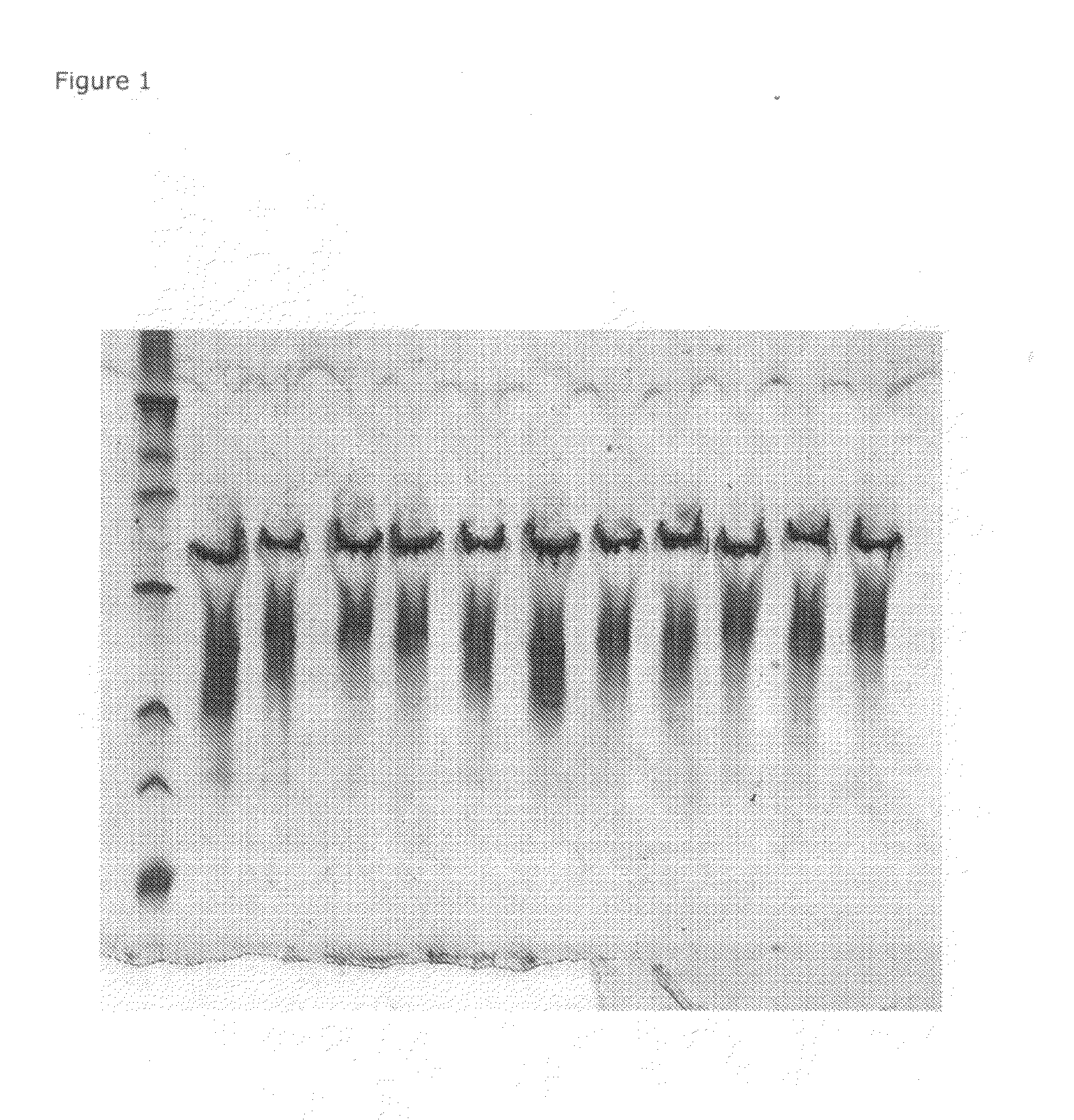Method For Producing An Acidified Milk Drink
a technology of acidified milk and milk, applied in the field of acidified milk drink production, can solve the problems of reducing the quality of acidified milk drinks, and achieve the effects of increasing stability, and reducing or eliminating the presence of live organisms
- Summary
- Abstract
- Description
- Claims
- Application Information
AI Technical Summary
Benefits of technology
Problems solved by technology
Method used
Image
Examples
example 1
SKMP Solution
[0132]20 ml water+4.5 g skim milk powder (instant dispersibility from Kerry) was incubated at 50° C. for 10 min before use, so a homogeneous solution was obtained.
Sugar Solution
[0133]3.3 g sucrose
10.5 g glucose
[0134]These sugars were added to 46 ml 20 mM lactic acid buffer, pH 4.0 and incubated at 90° C. for 5 min with stirring and then cooled down to 5° C.
[0135]Chromatographically purified Chryseobacterium deamidase (Example 3), 0.9 mg / ml, was diluted to give the final concentrations indicated in the Tables.
Procedure a (Enzyme Added Before Pasteurization)
[0136]250 ul SKMP solution was transferred to eppendorf tubes. 20 ul Enzyme or water (control) was added and incubation was performed for 120 min at 50° C.
[0137]The solution was incubated at 85° C. for 30 min with 1000 rpm and hereafter incubated at 43° C. for 10 min with 1000 rpm.
[0138]30 ul 4 U / l YF-3331 (mixed strain culture containing Streptococcus thermophilus and Lactobacillus delbrueckii subsp. bulgaricus ...
example 2
[0161]A dose response experiment was made according to Procedure B as described in Example 1.
[0162]Table 2 shows a decrease in syneresis with increasing deamidase concentration.
TABLE 2AveragedeviationDeamidasesyneresis(+ / −)ug / mlMmmmAdded after pasteurization02.50.11Added after pasteurization132.20.10Added after pasteurization291.60.00Added after pasteurization571.20.03
example 3
Cloning and Production of Deamidase
Cloning and Production
[0163]Chryseobacterium sp. was isolated from a soil sample from Antarctica from Jan. 19, 1989.
[0164]The deamidase gene was PCR amplified based on primers-designed from the sequences of known deamidases. (Genbank Acc no AB046594 (Eur J Biochem vol 268:1410-1421, 2001) and GenseqN Acc no AAZ49495 (EP976829)). The sequence obtained from such product is shown as SEQ ID NO: 1.
[0165]The signal peptide from the Savinase™ gene (the subtilisin protease of B. clausii) was fused by PCR in frame to the gene encoding the deamidase (SEQ ID NO: 5).
[0166]The fused gene was integrated by homologous recombination into the genome of the Bacillus subtilis host. The gene construct was expressed under the control of a triple promoter system (as described in WO 99 / 43835), consisting of the promoters from Bacillus licheniformis alpha-amylase gene (amyL), Bacillus amyloliquefaciens alpha-amylase gene (amyQ), and Bacillus thuringiensis cryIIIA promoter...
PUM
| Property | Measurement | Unit |
|---|---|---|
| temperature | aaaaa | aaaaa |
| pH | aaaaa | aaaaa |
| temperature | aaaaa | aaaaa |
Abstract
Description
Claims
Application Information
 Login to View More
Login to View More - R&D
- Intellectual Property
- Life Sciences
- Materials
- Tech Scout
- Unparalleled Data Quality
- Higher Quality Content
- 60% Fewer Hallucinations
Browse by: Latest US Patents, China's latest patents, Technical Efficacy Thesaurus, Application Domain, Technology Topic, Popular Technical Reports.
© 2025 PatSnap. All rights reserved.Legal|Privacy policy|Modern Slavery Act Transparency Statement|Sitemap|About US| Contact US: help@patsnap.com

